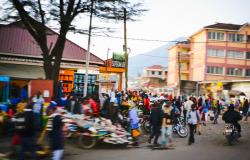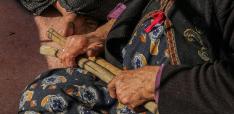Understanding Africa’s Development Challenges: Interview with Lynda Pickbourn

This is part of PERI's economist interview series, hosted by C.J. Polychroniou.
C.J. Polychroniou: You studied economics and history at the University of Ghana. Why economics?
Lynda Pickbourn: I grew up in Accra, Ghana in the 1970s, in a part of the city that Americans would consider poor or working-class. However, unlike many of my friends in the neighborhood, I was enrolled in a private school for the Ghanaian élite and expatriates, which meant that I straddled two very different worlds for most of my childhood and teenage years. My mother was a freelance journalist who wrote about the economic and social injustices that were prevalent in Ghana, and so I grew up with a heightened sense of the unfairness of the economic system, even if I didn’t have the language for it at the time.
In the 1970s, Ghana experienced a severe and prolonged economic and political crisis that culminated in the adoption of a structural adjustment program in 1983. Although I was quite young, I was very much aware of the human costs of the crisis and of the policies of economic austerity that followed, and of the ways in which these costs were borne more heavily by the poor. Some of my strongest memories from this period are of standing in long lines for bread and other basic commodities, all of which were strictly rationed. Corn is a staple of the Ghanaian diet and during a prolonged drought in the 1980s, food aid from the US was the only source of corn for Ghanaians. I particularly remember the sour taste and dry texture of this corn, which was rumored to have been grown for livestock consumption.
In the last two years of high school, while I was studying for my A-levels, I was lucky to have an excellent economics teacher who helped me to make the connections between the subject and the development challenges that Ghana was still experiencing. At the time, students applying to universities in Ghana had to declare their intended major in their application, and I decided that I would major in economics in the hope that it would help me find answers to the questions I had about poverty, inequality and development in Ghana. In addition to the required courses in economic theory, math and statistics, prospective economics majors at the University of Ghana were required to take a course in African economic history in their first year. While the other required economics courses for first-year students had a tidy and predictable logic to them, they were also quite abstract and not particularly helpful for understanding Ghana’s economic situation. In contrast, the economic history course made the links between theory, policy and development outcomes in Africa clearer, and it cemented my interest in economics as a major.
CJP: What led you to the USA and, more importantly, to pursue graduate studies in economics at the University of Massachusetts at Amherst?
LP: After I graduated from the University of Ghana, I taught economics at a high school in Accra to fulfill my national service obligation (all students were required to do two years of national service – one before entering university and one after graduation). Then for a variety of family-related reasons, I ended up teaching at the same school for another 8 years. When I was ready to begin graduate study, there wasn’t a PhD program at the University of Ghana, and the Education Advisor at the US embassy did a good job of convincing me that the US was a better option than the UK for graduate study in economics. In the course of my teaching career, I had become very much interested in inequality in access to education and development, and a Google search for those topics led me to Sam Bowles’ early work on education in the capitalist system and eventually to the webpage of the UMass Economics department. I wrote to Sam, who replied right away and put me in touch with two South African alums of the department. At the time, I knew nothing about heterodox approaches to economics or about the reputation of the department, but I found the research of the faculty listed on the department’s website much more interesting than what I had come across on the webpages of other departments. I was also struck by the fact that there were several development economists in the department, including one (Léonce Ndikumana) whose research was on Africa – other departments I had looked at seemed to have at most one development economist, and it was certainly unusual to find economists working on Africa. The alums I heard from also spoke highly of the department and of the diversity in approaches to economics. It seemed like it would be a good fit for me, and I was delighted when I was admitted to the PhD program.
CJP: Your primary research interests revolve around African economic development, with a focus on sub-Saharan Africa, and include investigations on the impact of foreign aid programs for Africa, and analyses of policies for informal employment, and gender, intra-house dynamics. Let’s start on the topic of foreign aid. According to your research, how effective is foreign aid in sub-Saharan Africa?
LP: It’s fair to say that the topic of aid effectiveness in Africa is highly contested and empirical research has done little to resolve the debate. Part of the problem is that most of the research on aid effectiveness has focused on the impact of aid on economic growth. While some researchers are convinced that aid does not contribute to growth, others argue that it does, while still others argue that aid is effective in achieving growth but only under very specific conditions. The difficulty here is that the conceptual link between aid and economic growth is tenuous. Most of the aid that Africa receives goes to support specific programs or sectors – not to bring about “economic growth.” To give a concrete example, Ghana might receive funding from a donor to support the construction of schools in rural communities. For this kind of aid to result in economic growth, several things have to happen: the schools need to be built, students need to be enrolled and attend classes, teachers need to show up and teach, students need access to textbooks, students must graduate and find employment, and so on. Obviously, this chain of causality between aid to the education sector and economic growth is only as strong as the weakest link. What we have argued in our work is that one of the reasons why we don’t see a conclusive relationship between aid and growth in Africa is that economists are asking the wrong questions. Rather than asking whether aid has a positive impact on economic growth, it is better to ask: does aid to health lead to improved health outcomes, or does aid to education lead to improved outcomes in the education sector? When we focus on the impact of aid to specific sectors such as health, water and sanitation and education in sub-Saharan Africa, as we have done in our work, we find that aid is effective in improving outcomes in those sectors.
CJP: In your research on the effectiveness of foreign aid on access to social services in sub-Saharan Africa, you have reached the conclusion that, with regards to the supply of water and sanitation, increased aid results in increased access to those services. Can you tell us more about these findings?
LP: Access to improved water sources and sanitation facilities remains a challenge for sub-Saharan Africa, with 32% of the population lacking access to improved water sources and 70% lacking access to improved sanitation facilities. There is also a significant rural-urban gap in access to both water and sanitation: only 56% and 23% of the rural population in the region has access to improved sources of water and sanitation, respectively, compared to 87% and 40% of the urban population. Also worrying is the fact that progress in increasing urban access has stagnated: urban access to sanitation increased by 1% between 1990-2015, while urban access to water increased by only 4%.
This has implications for health outcomes – inadequate access to clean water and improved sanitation is linked to diarrheal disease, especially among infants and children under the age of five. Among all developing regions, sub-Saharan Africa has the highest mortality rates from diarrhea in children under the age of five. In a paper that I co-authored with Léonce Ndikumana, we find that increasing access to improved water and sanitation in sub-Saharan Africa by 1 percent can reduce infant and child mortality rates from diarrheal disease by up to 24 deaths per 1000 live births. Inadequate access to water and sanitation also has implications for gender equality in the region. The burden of fetching water and caring for the sick falls primarily on women and girls, and the more time they spend fetching water and caring for those who fall sick from diarrheal disease, the less time they have to devote to paid employment or education.
Although increasing access to improved water and sanitation sources should be a development priority for African governments, financing remains a constraint on the ability of governments to expand and maintain water and sanitation infrastructure. Efforts to expand access have focused on mobilizing more financial resources domestically and through increased aid inflows to bridge the financing gaps in the provision of these services. Yet, aid to the water and sanitation sector as a share of total aid to the region has been on the decline since the 1980s, averaging about 5% in 1990-2010. During this period, the water and sanitation sector received a smaller share of total aid than education, agriculture, humanitarian services and infrastructure.
Prior research on the impact of aid to the water and sanitation sector has focused on cross-sectional analysis of large samples of aid-receiving countries, with, at best, a dummy variable for Africa. These analyses also assume that the relationship between aid and access to water and sanitation is linear and, more surprisingly, does not vary across countries. Our analysis focuses only on sub-Saharan African countries and distinguishes between rural and urban access. We also allow for the possibility of non-linearities and for cross-country heterogeneity in the impact of aid on access to water and sanitation. We find that increased aid to the water and sanitation section has a positive impact on rural access to improved sanitation and helps to reduce urban-rural disparities in access to sanitation. In the case of access to water we find that the effect of aid may vary across countries depending on country-specific circumstances. These findings have important implications for donors. In addition to scaling up aid disbursements to the region, donors also need to increase aid allocation to the water and sanitation sector, identify the constraints that may limit access to these services in individual countries and consider how to allocate and utilize foreign aid to alleviate these constraints.
CJP: In your study on the role of gender in households in Ghana, you show that in situations where women are the primary recipient of remittances, such households spent twice as much on education than households in which men are the primary recipient. What historical, sociological, and possibly cultural factors can help explain why gender matters in Ghana and elsewhere in sub-Saharan Africa? Do these factors differ in important ways from other countries you have studied?
LP: There is an abundant literature from a variety of disciplines, including economics, and across many different cultural contexts that demonstrates that gender matters for intra-household allocation. For example, evidence from several countries suggests that household savings, investment and expenditure patterns are affected by how decision-making power is allocated between women and men.
My study of women’s rural-urban migration in Ghana focused on the interplay between gender, migration and the intra-household flow of remittances. Most studies of the impacts of migration on migrants’ origin households have accepted without question two assumptions: first, that migration in developing countries is part of a household welfare-maximizing or risk-minimizing strategy, and second, that household income is pooled and decisions about the allocation of that income are made by the household. Closely linked to this is the assumption that remittances flow to the household head who then makes decisions about their use. Building on these assumptions, studies of the impact of remittances on receiving households that want to at least take gender seriously in their analysis have focused on the gender of the household head as a key variable.
If we set aside these assumptions, then the analysis of the impact of migrant remittances on households must try to answer several questions: how are migration decisions actually made, who in the household receives remittances, and how do they make decisions about spending the extra income? My research in Ghana shows that in the case of women’s migration, households are not always the primary decision-makers and the household head is not necessarily the primary recipient of remittances. The women migrants in my study are more likely than men migrants to direct their remittances to other women in their households – their mothers, sisters, co-wives and daughters – even when those individuals are not heads of the household.
Households in this part of the world are complex, multi-family structures, and the rules governing household budgeting and financial management assign different responsibilities to men and women. For example, male household heads are designated as farmers and are assigned responsibility for managing the household farm and for ensuring the supply of the food staple; all men in the household, once they are old enough, are also allocated a plot of land on which they can cultivate cash crops. The income from these private farms is considered personal income, to be used as the recipients wish, and with no requirement that it will be used to meet household needs. Women, in contrast, are considered farm “helpers”, not farmers, and as such, have no normatively defined claims on land. However, they are responsible for ensuring that household members are fed and children are cared for. When the household food staple runs out, as is increasingly the case because of declining agricultural yields, women often become primary providers of food. These responsibilities require women to make significant outlays of cash, which they typically generate by investing in small non-farm enterprises, and increasingly, by migrating to work in urban areas. These normatively defined responsibilities shape migrants’ ideas about how their remittances should be used. While male migrants are more likely to send remittances for the purpose of investing in their personal farms, women are more likely to send remittances to purchase food, care for children, or to make investments in their household enterprises. Both men and women migrants direct their remittances to those members of the household who, because of their specific roles in household financial management structures, would be more likely to use the remittances for their intended purpose. As a result, women in households that have at least one female migrant are more likely to be the primary recipient of remittances from that migrant. These households also spend more on children’s education than other households, suggesting that the receipt of remittances is either increasing the bargaining power of women over household expenditures on education, or more likely, since income is not pooled in this context, relaxing the women’s budget constraints and making it possible for them to spend more on children’s education.
What my research demonstrates is that the social and institutional context matters for understanding the interplay between gender and economic outcomes. What might be true of Ghana may not be true of Ethiopia, India or Mexico, and vice-versa. In the years since I completed my research, other studies from other parts of the world have documented the ways in which gender shapes migration and remittance behavior in households, although the specific ways in which this happens, and the reasons for it are highly dependent on context. I think it is important that researchers spend more time understanding the specificities of the context they are studying, rather than simply applying without question the assumptions and hypotheses that have been developed for different contexts.
CJP: More generally, what light do you think your research has shed on some of the main development challenges facing Ghana and other countries in Sub-Saharan Africa?
LP: I think my research makes it clear that Africa poses problems for conventional economic theory. This is not because Africa is a basket case, or because the development challenges facing the continent are insurmountable. The problems that Africa poses for economic theory arise because those theories were not developed for African economies, and are therefore inadequate in providing solutions to the continent’s development challenges. The economic system is not separate from the historical, cultural and institutional context, and Africa’s development challenges require economists to devote more time to studying and understanding the history, culture and institutions of the continent and to develop theories and policies that are grounded in the historical and institutional realities of the African context. Furthermore, even the notion of an African context itself needs to be problematized: Africa is a continent of 55 countries, and the historical and institutional context of even neighboring countries can be quite different. Taking Africa seriously in economic analysis requires economists to understand the implications of these historical, cultural and institutional differences for theory and policy, and to take these differences into account in building the models that are so central to our analysis and policy prescriptions.
Lynda Pickbourn is Associate Professor of Economics at Hampshire College and Senior Lecturer in Economics at the University of Massachusetts, Amherst. Her research interests lie at the intersection of economic development, feminist economics and political economy, with a focus on Africa. While carrying out field research on the rural-urban migration of women in Ghana, she also developed an interest in economic methodology and the use of mixed research methods in economics. She has authored or co-authored several articles and book chapters on aid effectiveness, rural-urban migration, informal employment and mixed methods research, and her work has been published in journals such as Feminist Economics, Journal of Development Studies, Journal of International Development and World Development. She is chair of the Five College African Studies Council and currently serves on the boards of the African Finance and Economics Association (AFEA), the Association for the Advancement of African Women Economists (AAAWE) and the International Association for Feminist Economics (IAFFE). She is also the book review editor of the journal Feminist Economics. A graduate of the University of Ghana, she received a Graduate Certificate in Advanced Feminist Studies as well as an MA and PhD in Economics from the University of Massachusetts, Amherst.
Photo by Blue Ox Studio from Pexels


